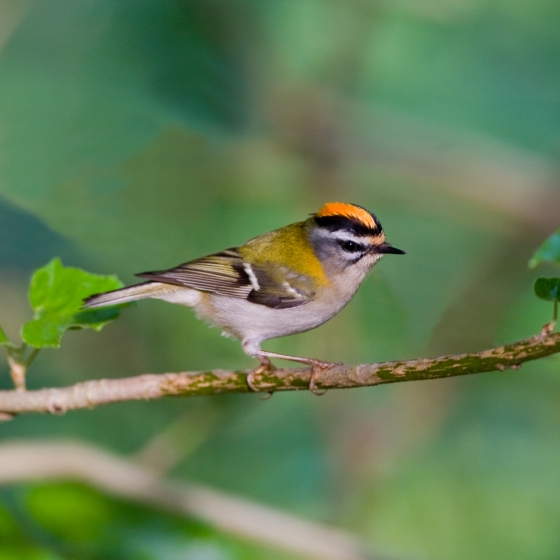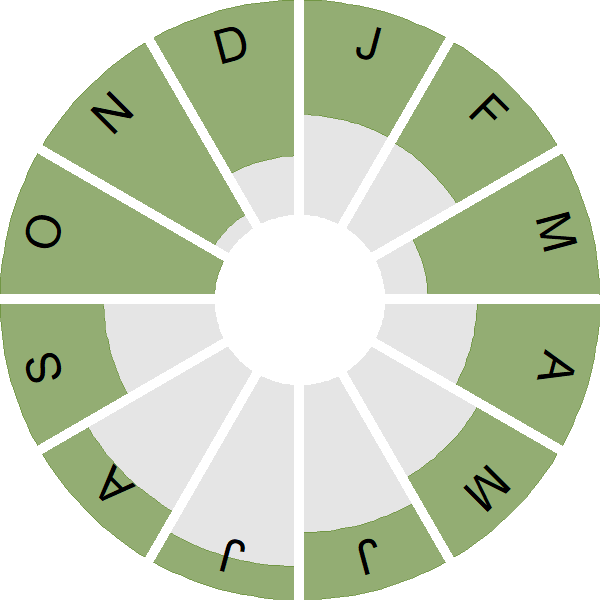Firecrest

Introduction
Firecrests could be considered 'souped-up' Goldcrests, closely resembling the latter in size, sound, behaviour and overall appearance, but with brighter and bolder makings.
The Firecrest a summer visitor to Britain & Ireland. It was first recorded breeding in Hampshire in 1962, and has since extended its breeding range north through much of southern, central and eastern England and into Wales. This species is only recorded on passage on the island of Ireland. In winter, some Firecrests migrate across the North Sea from Fennoscandia, and then this species is found more widely, including on the west coast of Wales and the Northern and Western Island of Scotland.
Like Goldcrests, Firecrests can often be found combing trees and bushes, especially conifers, for small invertebrate prey. They may form flocks with other small birds in autumn and winter. Their striking facial markings most easily set them apart from Goldcrests. They have prominent black and white head stripes as well as their crowning crests, which are more orange in males and more yellow in females.

Key Stats
Identification
ID Videos
This section features BTO training videos headlining this species, or featuring it as a potential confusion species.
Goldcrest & Firecrest
Songs and Calls
Song:
Status and Trends
Conservation Status
Population Change
Firecrest was first confirmed to have bred in the UK in 1962 in Hampshire (Adams 1966). The breeding distribution is concentrated on southern and eastern England and the range has strongly increased since the 1968–72 Breeding Atlas (Balmer et al. 2013). Breeding records from Wales and northern England (Balmer et al. 2013) suggest further range expansion is likely. Intensive survey efforts have confirmed that large local breeding populations occur at some key sites such as the New Forest in Hampshire and it has been suggested that the UK population could number over 4,000 pairs (Clements et al. 2017), although population density may be highly variable and hence further more widespread surveys are needed to produce a robust national population estimate.
Distribution
The Firecrest's breeding distribution is heavily concentrated within southeast and eastern England between Hampshire and Norfolk, with scattered records in Wales, southern and northern England. Densities are highest in southern England with local concentrations in East Anglia, Wales and Gloucestershire. This inland breeding distribution differs markedly from the mostly coastal distribution in winter.
Occupied 10-km squares in UK
or view it on Bird Atlas Mapstore.
or view it on Bird Atlas Mapstore.
European Distribution Map
Distribution Change
The change in breeding distribution is astounding, with a 935% increase in occupation of 10-km squares since the 1968–72 Breeding Atlas.
Change in occupied 10-km squares in the UK
or view it on Bird Atlas Mapstore.
or view it on Bird Atlas Mapstore.
Seasonality
Firecrest is a scarce winter visitor and rare breeder and autumn passage migrant.
Weekly pattern of occurrence
The graph shows when the species is present in the UK, with taller bars indicating a higher likelihood of encountering the species in appropriate regions and habitats.

Movement
Britain & Ireland movement
Foreign locations of birds ringed or recovered in Britain & Ireland
Dots show the foreign destinations of birds ringed in Britain & Ireland, and the origins of birds ringed overseas that were subsequently recaptured, resighted or found dead in Britain & Ireland. Dot colours indicate the time of year that the species was present at the location.
- Winter (Nov-Feb)
- Spring (Mar-Apr)
- Summer (May-Jul)
- Autumn (Aug-Oct)

European movements
EuroBirdPortal uses birdwatcher's records, such as those logged in BirdTrack to map the flows of birds as they arrive and depart Europe. See maps for this species here.
The Eurasian-African Migration Atlas shows movements of individual birds ringed or recovered in Europe. See maps for this species here.
Biology
Productivity and Nesting
Nesting timing
Egg measurements
Clutch Size
Survival and Longevity
Survival is shown as the proportion of birds surviving from one year to the next and is derived from bird ringing data. It can also be used to estimate how long birds typically live.
View number ringed each year in the Online Ringing Report.
lifespan
Biometrics
Wing length and body weights are from live birds (source).
Wing length
Body weight
Ring Size
Classification, names and codes
Classification and Codes
- Order: Passeriformes
- Family: Regulidae
- Scientific name: Regulus ignicapilla
- Authority: Temminck, 1820
- BTO 2-letter code: FC
- BTO 5-letter code: FIREC
- Euring code number: 13150
Alternate species names
- Catalan: bruel eurasiàtic
- Czech: králícek ohnivý
- Danish: Rødtoppet Fuglekonge
- Dutch: Vuurgoudhaan
- Estonian: lääne-pöialpoiss
- Finnish: tulipäähippiäinen
- French: Roitelet triple-bandeau
- German: Sommergoldhähnchen
- Hungarian: tüzesfeju királyka
- Icelandic: Gullkollur
- Irish: Lasairchíor
- Italian: Fiorrancino
- Latvian: sartgalvitis
- Lithuanian: baltabruvis nykštukas
- Norwegian: Rødtoppfuglekonge
- Polish: zniczek (zwyczajny)
- Portuguese: estrelinha-real
- Slovak: králik ohnivohlavý
- Slovenian: rdeceglavi kraljicek
- Spanish: Reyezuelo listado
- Swedish: brandkronad kungsfågel
- Welsh: Dryw Penfflamgoch
Research
Causes of Change and Solutions
Causes of change
The colonisation of the UK has followed considerable range expansion across continental Europe since the 1960s and mirrors the colonisation and rapid population growth in the Netherlands (Batten 1973; Hustings 2002). The reasons for this expansion are not known. It seems probable that climate change may have played a role in the recent rapid expansion but it is unclear whether or not this is the main driver and it is likely that other factors have also been important at least in the early stages of the colonisation which began before the effects of climate change became apparent.

